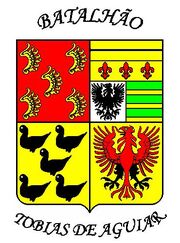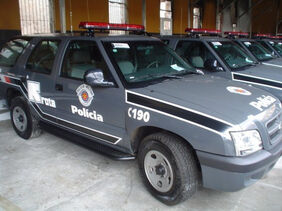m (Fix typo's and clean up some formatting, typos fixed: Sao Paulo → São Paulo) |
|||
| Line 7: | Line 7: | ||
Since its establishment, the Battalion had its effective presence in conflicts marked the history of Brazil and may be cited: |
Since its establishment, the Battalion had its effective presence in conflicts marked the history of Brazil and may be cited: |
||
| − | *Campaign of Parana, in 1894, known as Revolta da Armada. When he defended the Republic of the Federalists, advancing Itararé - |
+ | *Campaign of Parana, in 1894, known as Revolta da Armada. When he defended the Republic of the Federalists, advancing Itararé - São Paulo State - up Curitiba - Parana; |
*Question of the Protocols in 1896, when he defended the capital Consul of the Italy That revolted by the death of immigrants listed in the Legal Forces; |
*Question of the Protocols in 1896, when he defended the capital Consul of the Italy That revolted by the death of immigrants listed in the Legal Forces; |
||
*Campaign Straws in 1897, is responsible for the final battle that toppled the Redoubt Canudos, led by Antonio Conselheiro. His actions were positively mentioned in the book "The Hinterlands"By Euclides da Cunha, Which he referred to as "Battalion Paulista; |
*Campaign Straws in 1897, is responsible for the final battle that toppled the Redoubt Canudos, led by Antonio Conselheiro. His actions were positively mentioned in the book "The Hinterlands"By Euclides da Cunha, Which he referred to as "Battalion Paulista; |
||
| Line 44: | Line 44: | ||
==Advent of the current format== |
==Advent of the current format== |
||
| − | The so-called ''First Military Police Battalion "Tobias De Aguiar"'' purchased the current format, based on the mobility and effectiveness, starting in 1970 when, in the context of dictatorship, participated for the scrapping of a training center for guerrilla VPR active in Vale do Ribeira. Although successful, the remnants of the group escaped, among them Carlos Lamarca and Carlos [[File: |
+ | The so-called ''First Military Police Battalion "Tobias De Aguiar"'' purchased the current format, based on the mobility and effectiveness, starting in 1970 when, in the context of dictatorship, participated for the scrapping of a training center for guerrilla VPR active in Vale do Ribeira. Although successful, the remnants of the group escaped, among them Carlos Lamarca and Carlos [[File:1263445299865 f.jpg|thumb|left|282px|ROTA's official vehicle]]Marighella continue to militancy in the capital of Sao Paulo and Greater Sao Paulo; Promoted attacks on barracks, assassinations and kidnappings of politicians and military funded by bank robberies (called expropriations). The group was accused of terrorism by the regime. The Battalion is reformulated to curb urban guerrilla. It is installed at the headquarters of Battalion Tobias de Aguiar "a communications center in order to support the vehicles in service. The vehicles are equipped with a radio transceiver for greater agility in operations with the Military Police Aguiar Base or the car in policing, the police receive the black beret as a trademark. Under the command of Lt.-Col. Salvador D'Aquino the group will take the role of bank round, urban patrolling and riot police to act where the joint was not able to do so. On October 15, 1970, shall be called ''Rounds Ostensive Tobias de Aguiar'' - ''ROTA''. |
[[Category:Special Forces]] |
[[Category:Special Forces]] |
||
[[Category:Brazilian special forces]] |
[[Category:Brazilian special forces]] |
||
Revision as of 01:01, 21 September 2013
Rounds Ostensive Tobias de Aguiar, Better known by his acronym ROTA, Is a form of policing of the 1st Battalion Policing Shock - "Tobias de Aguiar"- And a reserve army of the General Command of Military Police of São Paulo.
Constitutes a tactical force of the Military Police, which aims to enable flexibility and responsiveness with the use of motorized policing. Used in the need to control civil unrest through the group of vehicles, as appropriate, Group, Platoon, Company or Battalion of Shock.
The history of the Battalion
With the advent of Republic then the Police Corps Standing was on December 1, 1891, divided into four bodies, going to be called the Public Force, at which time the Battalion was named 1st Corps Military Police, whose mission was to keep the peace, assist the justice and defending the Republican Institutions. After several denominations, started to show its current name on December 15, 1975.
Since its establishment, the Battalion had its effective presence in conflicts marked the history of Brazil and may be cited:
- Campaign of Parana, in 1894, known as Revolta da Armada. When he defended the Republic of the Federalists, advancing Itararé - São Paulo State - up Curitiba - Parana;
- Question of the Protocols in 1896, when he defended the capital Consul of the Italy That revolted by the death of immigrants listed in the Legal Forces;
- Campaign Straws in 1897, is responsible for the final battle that toppled the Redoubt Canudos, led by Antonio Conselheiro. His actions were positively mentioned in the book "The Hinterlands"By Euclides da Cunha, Which he referred to as "Battalion Paulista;
- Raise of the Copacabana Fort: In 1922, defending the borders of the State against invasion from the Parana;
- Revolution in 1932: Where people fought for the return of Sao Paulo Brazil to Constitutionality, applauding Pedro Toledo governor;
- Military Coup 64:When he attended the overthrow of then President of the Republic João Goulart, Beginning the dictatorial military government with General Castelo Branco
- Campaign River Ribeira de Iguape in 1970 to quell the guerrilla movement established by Rural Carlos Lamarca.
The Barracks
The Battalion Tobias de Aguiar, established on 1 December 1891, was the third barracks built in the then Permanent Police Corps. Designed by the noted architect Ramos de Azevedo and inspired by the French military architecture, the style originated in Europe in the first half of Nineteenth Century with the name "Post-Style Napoleonic". Modeled a Headquarters French Foreign Legion at Morocco. In his basement is a network of tunnels that made links with the neighboring barracks and the railway station.
The material for its construction came from various parts of the world: French tiles, bricks and pine of Italy in Riga, Latvia. Currently, the building is historical and is listed by CONDEPHAAT. Beyond the tunnel, there is the chimney, located on the outside near the building, which served as a reference during the Revolution of 1924 And today marks with shots guns in four points.
Coat of 1st BPChq "Tobias de Aguiar"
Creation: Decree No. 20 986 of 1 December 1951. Shield: Bicudo, French style Quartered. Its Meaning:
Field 1 - Top Left: In gules (red), which symbolizes the courage, grandeur, and fighting spirit, five wings eagle Santor on which is

Coat of Arms Battalion Tobias de Aguiar.
the symbol of speed in military expeditions, gold symbolizing the splendor, sovereignty and stability.
Field 2 - Upper Right: In gold with two bands decreased, which symbolizes the knight's belt, beneath these, three fleurs-de-lis of sips (red) at the bottom, a shield on a white background which is the symbolism of purity and the ideal, an eagle sable (black) and three other tracks in the right sinoper (green) which is symbolic of victory, and honor civility.
3rd Field - Lower Left: Gold, five in Martlet Santor symbolizing an indication of the defeated enemies in battle, in sable (black) which is the symbolism of simplicity, wisdom, Science and honesty.
Field 4 - Lower Right: In gold, one eagle gules (red) and black membrane, which is the symbolism of power, victory and prosperity, which identifies the name of AGUIAR and the 1st Battalion of Shock "TOBIAS DE AGUIAR.
Armament
There are several types of firearms used by ROTA:
- Pistol Taurus PT 100 (Brasil)
- Pistol Taurus PT 24/7 (Brasil)
- Assault Rifle IMBEL MD-97 (Brasil)
- Semi-Automatic Taurus CT-40
- Shotgun Remington 870 (EUA)
- Shotgun Benelli M3 (Italy)
- Sub-machine gun Beretta M12 (Italy)
- Sub-machine gun Taurus MT-40 (Brasil)
Advent of the current format
The so-called First Military Police Battalion "Tobias De Aguiar" purchased the current format, based on the mobility and effectiveness, starting in 1970 when, in the context of dictatorship, participated for the scrapping of a training center for guerrilla VPR active in Vale do Ribeira. Although successful, the remnants of the group escaped, among them Carlos Lamarca and Carlos

ROTA's official vehicle
Marighella continue to militancy in the capital of Sao Paulo and Greater Sao Paulo; Promoted attacks on barracks, assassinations and kidnappings of politicians and military funded by bank robberies (called expropriations). The group was accused of terrorism by the regime. The Battalion is reformulated to curb urban guerrilla. It is installed at the headquarters of Battalion Tobias de Aguiar "a communications center in order to support the vehicles in service. The vehicles are equipped with a radio transceiver for greater agility in operations with the Military Police Aguiar Base or the car in policing, the police receive the black beret as a trademark. Under the command of Lt.-Col. Salvador D'Aquino the group will take the role of bank round, urban patrolling and riot police to act where the joint was not able to do so. On October 15, 1970, shall be called Rounds Ostensive Tobias de Aguiar - ROTA.